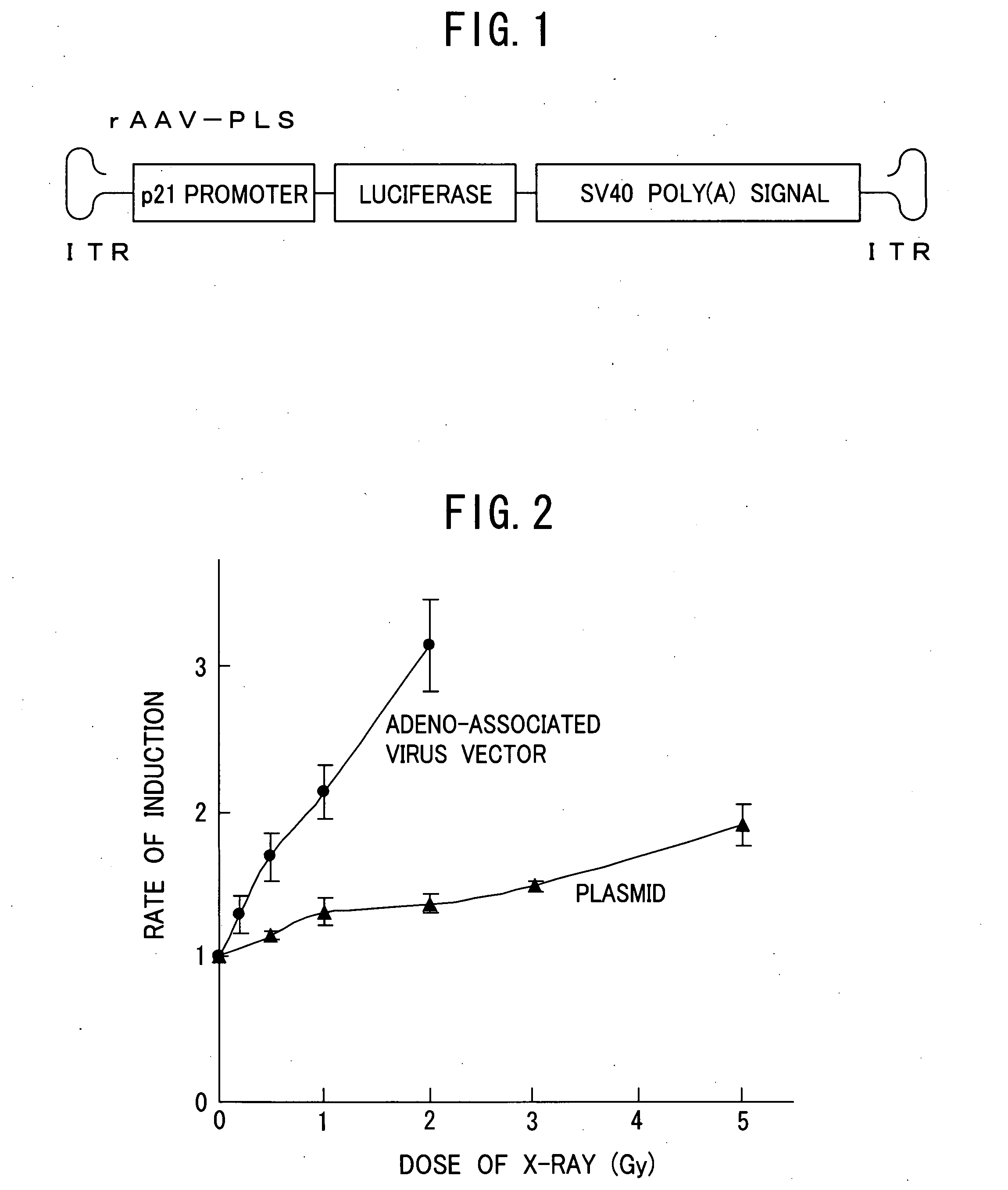Integration-type low-dose radiation-inducible vector
- Summary
- Abstract
- Description
- Claims
- Application Information
AI Technical Summary
Benefits of technology
Problems solved by technology
Method used
Image
Examples
example 1
Integration-Type Low-Dose Radiation-Inducible Viral Vector
[0079] In the present example, a low-dose radiation-inducible viral vector rAAV-PLS was constructed based on a type 2 adeno-associated virus, having the p21 gene promoter sequence as the p53 target gene promoter sequence, and having the luciferase gene sequence corresponding to the therapeutic gene sequence. rAAV-PLS was constructed by the triple transfection method (Xiao X, Li J, Samulski R J. Production of high-titer recombinant adeno-associated virus vectors in the absence of helper adenovirus. J Virol 1998; 72: 2224-2232. and Matsushita T, Elliger S, Elliger C, Podsakoff G, Villarreal L, Kurtzman G J, Iwaki Y, Colosi P. Adeno-associated virus vectors can be efficiently produced without helper virus. Gene Ther 1998; 5: 938-945.) using the AAV Helper Free System (Stratagene).
[0080] First, HindIII was used to excise from the plasmid wwp-Luc (El-Deiry W S, Tokino T, Velculescu V E, Levy D B, Parsons R, Trent J M, Lin D, Mer...
example 2
Pharmaceutical Composition Comprising Integration-Type Low-Dose Radiation-Inducible Viral Vector
[0103] The low-dose radiation-inducible viral vector rAAV-PLS produced in 293 cells was recovered by four freeze-thaw cycles, then centrifuged at 10,000 g for 10 minutes and concentrated. The obtained concentrate contained the low-dose radiation-inducible viral vector rAAV-PLS and a buffer solution.
example 3
Transduction Using Integration-Type Viral Vector
(1) Transduction
[0104] MCF-7 cells, which are human breast cancer cells expressing p53, were used as host cells.
[0105] MCF-7 cells were transduced with viral vector (multiplicity of infection: 5.5×103) by mixing 0.25 ml of pharmaceutical composition prepared in Example 2 (viral inoculum) (containing 5.5×108 rAAV-PLS viral particles) and 105 MCF-7 cells in a 12-well microplate, and incubating for 24 hours (culturing in 2 ml of RPMI1640 containing 10% fetal bovine serum, in an atmosphere at 37° C. containing 5% carbon dioxide). Then, cells were washed with PBS to remove the viral inoculum and cultured in an RPMI1640 culture medium (Life Technologies) supplemented with 10% FBS (JRH), 100 unit / ml penicillin and 100 μg / ml streptomycin (Life Technologies), at 37° C., under 5% CO2 in a humidified atmosphere.
(2) X-Ray Irradiation
[0106] MCF-7 cells cultured for 66 days after being transduced were irradiated with various doses of X-ray (0...
PUM
| Property | Measurement | Unit |
|---|---|---|
| Composition | aaaaa | aaaaa |
| Therapeutic | aaaaa | aaaaa |
Abstract
Description
Claims
Application Information
 Login to View More
Login to View More - R&D
- Intellectual Property
- Life Sciences
- Materials
- Tech Scout
- Unparalleled Data Quality
- Higher Quality Content
- 60% Fewer Hallucinations
Browse by: Latest US Patents, China's latest patents, Technical Efficacy Thesaurus, Application Domain, Technology Topic, Popular Technical Reports.
© 2025 PatSnap. All rights reserved.Legal|Privacy policy|Modern Slavery Act Transparency Statement|Sitemap|About US| Contact US: help@patsnap.com



